Scientific Program
Physiological and pathological processes
RESEARCH GROUP
Pathogenic mechanisms of Alzheimer’s disease

María Jesús Bullido Gómez-Heras
Our team studies the mechanisms connecting Alzheimer’s disease, the most common form of dementia, with the highly prevalent virus Herpes Simplex I. We develop models derived from human multipotent cells to assess these mechanisms, and perform clinical studies to validate our findings. With this strategy, we also aim to identify new biomarkers and therapeutic targets for this complex disease.

Research
To identify genes and mechanisms involved in the neurodegeneration characteristic of Alzheimer’s disease (AD), we developed cell models that reflect different aspects of the pathogenesis of the disease. These models allow us to identify new genes/functions associated with AD, which could be therapeutic targets for the disease. To do this, we analyze differential gene expression in the models and develop genetic association studies and biomarkers in clinical samples. In recent years, we have focused on models of herpes simplex virus 1 (HSV-1) infection that present characteristic markers of AD, including alterations in the trafficking, metabolism and proteolysis of the amyloid precursor protein (APP), as well as in the phosphorylation of the tau protein.
The study of the lysosome autophagy pathway in these models indicates that HSV-1, especially in the presence of oxidative stress, profoundly affects the final stages of the pathway, causing an increase in lysosomal content accompanied by a significant reduction in the activity of different cathepsins and in the degradation of lysosomal substrates. The evidence that another alpha-herpesvirus with neurotropic properties, HSV-2, induces the same neurodegeneration markers as HSV 1, supports the possible involvement of various infectious agents like as herpesviruses in AD-associated neurodegeneration.
The results of the functional and genetic/biomarker association studies developed so far support the hypothesis that lysosomal function failure could constitute a relevant mechanism in HSV-1-induced neurodegeneration and, in general, in AD type neurodegeneration, so our group is focused on the study of this functional pathway. Currently, we are developing more complex cell models, based on human NPCs, to validate our previous findings in a more physiological environment and delve deeper into the mechanisms involved.
In addition, we participate in several collaborative projects. The most numerous are those aimed to study the genetic architecture of AD, within the framework of the Spanish Consortium for Dementia Genetics (DEGESCO) and the international consortia EADB and IGAP, which continue to reveal new factors and relevant functions in the pathogenesis of this disease.
Group members

Mª Jesús Bullido Gómez-Heras
Lab.: 410 Ext.: 4567/ 4674
mjbullido(at)cbm.csic.es

Isabel Sastre Merlín
Lab.: 409 Ext.: 4674
isastre(at)cbm.csic.es

Jesús Aldudo Soto
Lab.: 410 Ext.: 4674
jaldudo(at)cbm.csic.es

Blanca Salgado Fuentes
Lab.: 410 Ext.: 4674
bsalgado(at)cbm.csic.es

María Martín Rico
Lab.: 410 Ext.: 4674
maria.martin(at)cbm.csic.es
Selected publications
Herpes Simplex Virus Type 1 Induces AD-like Neurodegeneration Markers in Human Progenitor and Differentiated ReNcell VM Cells
Blanca Salgado et al.
The lysosome system is severely impaired in a cellular model of neurodegeneration induced by HSV-1 and oxidative stress
Henrike Kristen et al.
Cholesterol dysregulation in peripheral blood mononuclear cells of Alzheimer’s disease
A Martín-Montes et al.
Common variants in Alzheimer’s disease and risk stratification by polygenic risk scores
Itziar de Rojas et al.

